How To Play Roulette

Unlike craps or blackjack, roulette is more of a "spectator sport". Your only involvement in game play is placing your bet (chips) on the layout. The dealer does all the work. Note that due to it's French origins, a roulette dealer is called a croupier (pronounced croop-ee-ay). Also unlike blackjack, you can still play if there are no open seats at the table. You'll just have to reach in between two seated players to place your bets.
Every roulette table has a lighted board that shows which number came up on the most recent rolls. What does this board really tell you? Absolutely nothing. The "law of independent trials" dictates that each roulette play is completely random and has nothing to do with any previous plays. Just because red came up the previous six times doesn't mean black is "due" to come up. Red has as much chance of coming up on the next play as it did the previous six plays. The wheel has no memory. Those lighted boards are their for the casinos advantage, not yours. Why? Because people don't know about the law of independent trials and if they see one color come up several times in a row most of them will bet the opposite color, and lose. The casinos put those boards up because they win more when players pay attention to them. In short, ignore the lighted boards.
Some gambling books claim that you can spot "tendencies" in certain wheels to come up one way or another. That's hog-wash. The casinos make their money due to the randomness of the game and if any such tendency did start to develop (due to wear and tear on the wheel) they would immediately replace it. The casinos, and the Nevada Gaming Commission, go to great lengths to ensure that no such wheels exist.
Roulette has a high house edge (over 5%) due to the '0' and '00' locations on the wheel. As a result, you don't want to spend a lot of time at a roulette table because the longer you play the better chances are the odds will catch up with you. However, playing roulette is fun, and the little routine I have outlined here will give you a chance to enjoy the game and possibly make a little money in the process.
It's best not to have a towering stack of 32 chips sitting there while you're playing because it could easily get knocked over and create a mess. Instead:
You will now have seven stacks of 8 chips. This way you can stack up two of the 8-chip stacks to create the 16-chip stack, and four of them to create the 32-chip stack, once it's time to bet them. You'll want to keep your 8-chip stacks grouped according to their bet though, so you don't lose track of which bet you're on (see the diagram where the number on the chips represents how many chips are in the stack). Note that when you do go to place the 16 and 32-chip bets you do have to stack them up into one tall stack before sliding them onto your position on the layout.
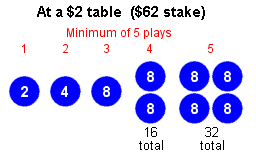
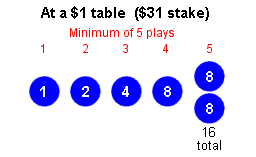
Pick one of the three "dozen" bet positions ('1st 12', '2nd 12', '3rd 12') or one of the three "column" bet positions. Both dozen and column bets cover 12 numbers and pay 2:1.
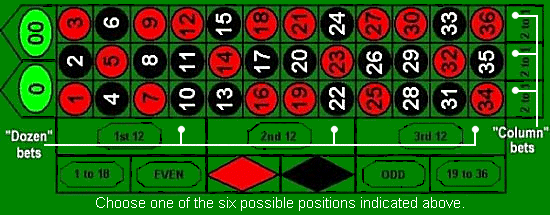
The reason I say "walk away" is because of roulette's high house edge so the longer you play to more likely you are to lose any gains you may have made.
Because the dozen and column bet positions pay 2:1, if you hit a hot streak you could do quite well with this little routine. The possible outcomes are:
Worst case - you lose on five consecutive spins and you're out $62 (it happens)
Not so bad - you win some of the lower bets but lose on the $32 spin coming out up or down
Even better - you lose on the first four spins but win on the $32 spin and walk away with $96
Best case - you win a lot of the lower bets and hit on the $32 spin and walk away with double or possibly even more your original stake
It is getting harder and harder to find anything less than a $5 roulette table. What if you can't find a $2 or $1 table? You can still try this progressive game without risking a lot of money. However, you'll only have four minimum plays rather than the five minimum plays the $2 and $1 tables give you. This is a full 20% reduction in the number of chances you have for the ball to land on your chosen "dozen" or "column" position so you may want to search out a $2 or $1 table. (You could go to five plays on a $3 table but that would require a stake of $93.) But if you can't find a $2 or $1 table, or you're just short on time, you can still do well if luck is on your side. Here's how you would play a $3 table and a $5 table.
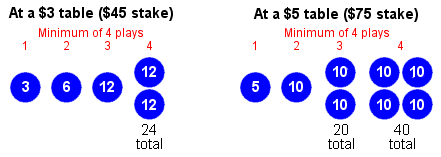
Another alternative I like to play at a $5 table is to wager a little more ($95) and have a minimum of five plays. You basically set up your chips for a table with a $3 minimum but just add $2 to your first bet to meet the table minimum.
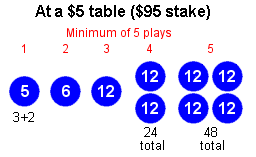
When the ball starts to drop the croupier will wave their hand over the layout indicating that no more bets can be placed. Any chips placed on the layout after that will not be counted in the current play.
When the ball drops onto a number the croupier places a plastic marker on the winning number, collects losing bets and pays winning bets. Wait until the croupier removes the plastic marker before picking up any winnings or placing the next bet. If you're ahead when you finish this routine, remember to tip the croupier when you cash out and walk away.
If you're just passing through and you want to place a quick bet on a certain number or on one of the other areas of the layout, you don't have to ask the croupier for a color. It is perfectly acceptable to put the house's chips, or even cash, down on the layout. Note that the red, black, odd, even, 1-18, and 19-36 areas of the layout pay even money. The individual numbers pay 35:1, but only have a 1:38 chance of coming up.